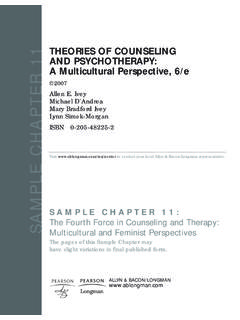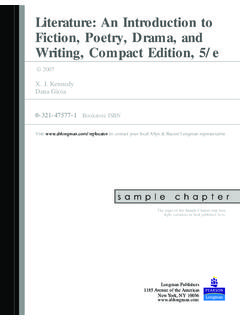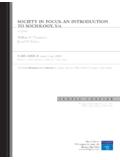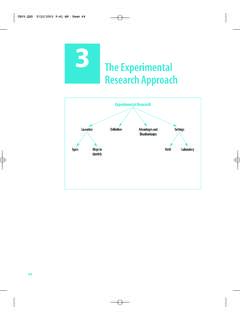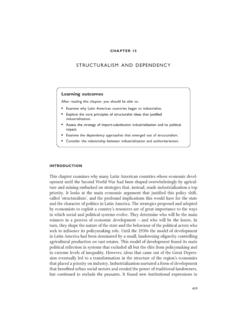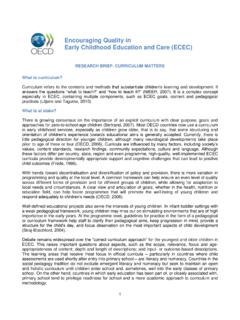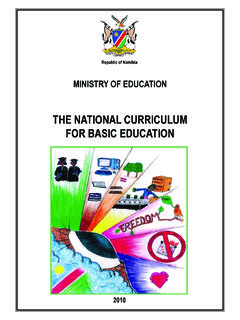Transcription of INCLUDING STUDENTS WITH SPECIAL NEEDS:A …
1 Marilyn Friend, University of North Carolina - GreensboroWilliam Bursuck, Northern Illinois UniversityAllyn & Bacon75 Arlington St., Suite 300 Boston, MA 2006sample chapter 5 The pages of this Sample Chapter may haveslight variations in final published contact your local Allyn & Bacon/Longman STUDENTS with SPECIALNEEDS: A PRACTICAL GUIDE FORCLASSROOM TEACHERS, 4/EPlanning Instructionby AnalyzingClassroom andStudent 5/26/2005 2:53 PM Page 144MR. RODRIGUEZTEACHES world history at a largeurban high school. When he introducesnew content to his STUDENTS , he teachesto the whole class at once. First, he re-views material that has already beencovered, pointing out how that materialrelates to the new content being pre-sented. Next, he provides any additionalbackground information that he thinkswill help STUDENTS understand the newmaterial better. Before Mr. Rodriguezactually presents new material he handsout a partially completed outline of themajor points he will make.
2 This outlinehelps STUDENTS identify the most impor-tant information. Every 10 minutes orso he stops his lecture and allows stu-dents to discuss and modify the outline andask questions. When Mr. Rodriguez completes his lec-ture he organizes STUDENTS into cooperative learninggroups of four to answer a series of questions on the lec-ture. Manuel is a student with a learning disability in s class. He has a history of difficulty staying ontask during lectures and figuring out what information towrite down. He also has trouble remembering informa-tion from one day to the next. How well do you thinkManuel will perform in Mr. Rodriguez s class? What changes in theclassroom environment might help Manuel to succeed?JOSH HAS CEREBRAL is in thenormal range in ability. However, he has lots of troublewith muscle movements, has little use of his lower bodyand legs and also has problems with fine muscle coordi-nation. As a result, Josh uses a wheelchair, has troublewith his speech (he speaks haltingly and is difficult tounderstand) and struggles to write letters and numberscorrectly.
3 Josh is included in Ms. Stewart s second-gradeclass. What aspects of the classroom environment do youthink Ms. Stewart will need to adapt for Josh? How do you thinkshe could use technology to facilitate Josh s inclusion?Academic learning time (p. 161)Assistive technology (AT) (p. 171)Differentiated instruction (p. 148)Direct instruction (p. 173)INCLUDE strategy (p. 146)Indirect instruction (p. 176)Inquiry learning (p. 176)Instructional accommodations(p. 152)Instructional modifications(p. 154)Mixed-skill groupings (p. 164)One-to-one instruction (p. 164)Same-skill groupings (p. 164)Scaffolding (p. 177)Transition time (p. 161)Universal design (p. 147)KEY TERMS AND CONCEPTSLEARNER OBJECTIVESA fter you read this chapter, you will be able what it means to make reasonable adaptations forstudents with SPECIAL the steps of the INCLUDE decision-making processfor accommodating STUDENTS with SPECIAL needs in and describe the key elements of a the major components of classroom organization,and explain how they can be adapted for STUDENTS withspecial various ways that STUDENTS can be grouped forinstruction in an inclusive how the use of effective classroom materials andinstructional methods can benefit STUDENTS with 5/26/2005 2:53 PM Page 145 Disabilities and other SPECIAL needs arise when characteristics of individual studentsand various features of STUDENTS home and school environments interact.
4 Effective teach-ers analyze their classroom environment in relation to STUDENTS academic and socialneeds and make adaptations to ensure student success in the classroom. For example,Manuel has difficulty staying on task and retaining new information. However, featuresof Mr. Rodriguez s class make it easier for Manuel to function. The partially completedlecture outlines help Manuel focus his attention on specific information as he tries to lis-ten and stay on task; the pauses help him catch any lecture information he might havemissed. The review sessions are intended to help Manuel retain information by givinghim a mechanism for rehearsing newly learned material. In another case, Josh has someserious motor problems, but he may be able to function quite independently if Ms. Stew-art makes her classroom accessible to a wheelchair and works with SPECIAL educators touse assistive technology to meet Josh s needs in handwriting and oral chapter introduces you to a systematic approach to helping all STUDENTS withspecial needs gain access to the general education curriculum, a requirement of of that approach is for you to be the best teacher you can be so that fewer of yourstudents require individualized instruction in the first your best efforts, however, there will always be stu-dents who require a more individualized approach.
5 The IN-CLUDE strategy is provided for these STUDENTS . Althoughthere are other ways to adapt instruction for STUDENTS withspecial needs , INCLUDE gives teachers a systematic processfor making adaptations for STUDENTS based on their individualneeds and the classroom demands on or expectations of theteacher. The rest of the text especially Chapters 8 through13, in which specific strategies are presented expands andelaborates on this approach. Later chapters also present amore in-depth look at the relationship between your class-room environment and the diverse needs of learners. An im-portant assumption throughout the text is that the more effective your classroomstructure is, the greater the diversity you will be able to accommodate and the fewer in-dividualized classroom changes you will need to Can the INCLUDE Strategy Help YouMake Reasonable Adaptations for STUDENTS withSpecial needs ?At a recent conference presentation that included both classroom teachers and specialeducation teachers, one of the authors of this text asked the audience how many of thosepresent worked with STUDENTS with disabilities.
6 A music teacher at the back of the roomcalled out, Everyone in schools works with STUDENTS with disabilities! He is right. Asyou have learned in the previous chapters, IDEA entitles STUDENTS with disabilities to access, participation, and progress in the general education curriculum. Theseentitlements were reinforced by the No Child Left Behind Act of 2001 (NCLB), whichrequires that most STUDENTS with disabilities meet the same standards as their classmateswithout disabilities. Therefore, although the professionals who specialize in meetingthe needs of STUDENTS with disabilities are valuable and provide critical instructional andsupport systems for STUDENTS , ultimately, you and your peers will be the primary teach-ers for many STUDENTS with disabilities and other SPECIAL needs , and you will form part-nerships with SPECIAL educators to meet the needs of others. That makes it critical foryou to feel comfortable making adaptations for STUDENTS in order for them to have fairaccess to your gives teachers asystematic process for makingadaptations for STUDENTS basedon their individual needs andthe classroom demands on or expectations of theteacher.
7 RESEARCHNOTEThe connection betweeneffective instruction andpositive student behavioris well established (Scottet al., 2001). STUDENTS whoare successful have littleincentive to disrupt theclass or to act in ways thatget them excluded 5/26/2005 2:53 PM Page 146 How Can the INCLUDE Strategy Help You Make Reasonable Adaptations for STUDENTS with SPECIAL needs ?147 The INCLUDE strategy is based on two key assumptions. First, student perfor-mance in school is the result of an interaction between the student and the instruc-tional environment (Pisha & Coyne, 2001; Smith, 2004). Consequently, what happensin a classroom can either minimize the impact of STUDENTS SPECIAL needs on their learn-ing or magnify it, making adaptations necessary. In the first chapter-opening example,Mr. Rodriguez engaged in a number of teaching practices that minimized the impactof Manuel s learning disability, such as starting each class with a review of material cov-ered the day before, providing the STUDENTS with lecture outlines to help them identifyimportant ideas, and engaging his STUDENTS in regular discussions of the material pre-sented.
8 Nevertheless, if part of Manuel s learning disability is in reading and the class-room text used in Mr. Rodriguez s class is too difficult for Manuel to readindependently, Mr. Rodriguez will need to make an individualized adaptation forManuel as second key assumption of INCLUDE is that by carefully analyzing STUDENTS learning needs and the specific demands of the classroom environment, teachers canreasonably accommodate most STUDENTS with SPECIAL needs in their classrooms. You canmaximize student success without taking a disproportionate amount of teacher time ordiminishing the education of the other STUDENTS in the class. For example, with thehelp of the SPECIAL education teacher, Mr. Rodriguez provided Manuel with a digitaltext with a built-in speech-to-print component and study guide. Soon, Mr. Rodriguezdiscovered that other STUDENTS in the class could also benefit from using the digital textand made it available to them. In this way, reasonable adaptations often assist many stu-dents in the INCLUDE strategy contains elements of both universal design and differen-tiated instruction, two widely recognized approaches to addressing classroom diversityin general, and inclusion in particular.
9 The idea of universal designoriginated in thefield of architecture, where it was learned that designing buildings for persons withdiverse needs from the beginning makes them more accessible and saves money spenton costly retrofits of ramps and automatic doors. As applied to classrooms, the idea isthat instructional materials, methods, and assessments designed with built-in supportsare more likely to be compatible with learners with SPECIAL needs than those withoutsuch supports (Curry, 2003; Hitchcock, Meyer, Rose, & Jackson, 2002; Pisha & Coyne,2001), and they minimize the need for labor-intensive adaptations later on. Forexample, print alternatives such as graphics, video, and digital text allow STUDENTS withHow does the concept of universaldesign relate from architecture toteaching? How does this conceptsimplify the job of a general edu-cation teacher?WWWRESOURCESFor more information onuniversal design, go to theTeaching Every Studentpage of the Center for Ap-plied SPECIAL Technology(CAST) website: 5/26/2005 2:53 PM Page 147reading problems to more readily access subject content.
10 The use of templates withpartially filled-in sections and links to more information can help STUDENTS construct abetter essay. The INCLUDE assumption that a well-designed classroom requiresfewer adaptations for STUDENTS with SPECIAL needs is consistent with the universal idea behind differentiated instructionis that a variety of teaching and learn-ing strategies are necessary to meet the range of needs evident in any given to Tomlinson (2000), STUDENTS diverse needs can be met by providing ma-terials and tasks at varied levels of difficulty, with varying degrees of support, throughthe use of multiple grouping arrangements and with time variations. The INCLUDE process of determining student supports based on student needs and classroom de-mands is an ideal vehicle for implementing differentiated instruction in your class-room. See the Professional Edge in Chapter 9 on page 314 for an example ofdifferentiated instruction as it applies to beginning reading instruction for studentswith SPECIAL INCLUDE strategy for accommodating STUDENTS with SPECIAL needs in thegeneral education classroom follows seven steps:Step 1 Identify environmental, curricular, and instructional classroom 2 Note student learning strengths and 3 Check for potential areas of student 4 Look for potential problem 5 Use information gathered to brainstorm instructional 6 Decide which adaptations to 7 Evaluate student steps are designed to apply to a broad range of SPECIAL needs and classroom en-vironments.
